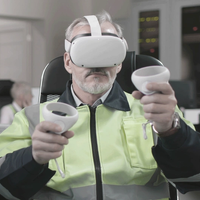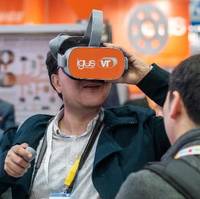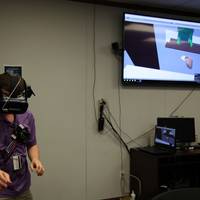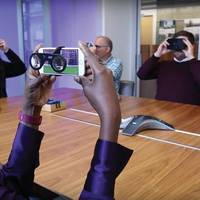Maersk Training and SynergyXR Enter Strategic Partnership

Maersk Training has announced a strategic alliance with SynergyXR to strengthen its ability to create extended reality training solutions. Extended reality (XR) is an umbrella term that covers all immersive technologies, including augmented reality (AR), virtual reality (VR) and mixed reality (MR).With the addition of SynergyXR’s advanced capabilities, Maersk Training promises a more interactive, deeper learning experience. Learners can enjoy delving deep into realistic scenarios…
The igus Factory Travels Around the World

A new app from German manufacturer igus offers unique insight into its production and development. Equipped with virtual reality (VR) headsets, the company's technical sales consultants now have the capability to show customers the igus factory in Cologne, Germany regardless of where the customers reside.Guided factory tours, popular among customers in the industrial community, offer an opportunity to experience products and witness manufacturing on site. However, these tour are not always possible…
Oil and Gas Industry Adopts VR
The oil and gas industry is witnessing wide-scale deployment of virtual reality (VR) technology across its value chain, according to GlobalData.According to the report, ‘Virtual Reality in Oil & Gas’, VR is finding its way into upstream, midstream and downstream sectors with applications in the simulation of new processes, analysis of project designs, reviewing of maintenance requirements and planning disaster responses.Ravindra Puranik, Oil and Gas Analyst at GlobalData, said: “Over time, this technology will transform oil and gas processes and workflows and help create new growth opportunities for organizations.”VR provides an interactive experience for oil and gas processes within a simulated environment and presents a superior alternative to images…
MOL Upgrades VR-based Safety Education Tool
Japanese transport company Mitsui O.S.K. Lines (MOL) announced the development of new content for its virtual reality (VR)-based marine safety education program, allowing trainees to virtually capture the sensations of "falling", "hand being caught between something", and experiencing "an incinerator explosion incident".The program uses VR goggles and VR technology created by Tsumiki Seisaku. With the VR tool, trainees can experience onboard operations, with computer graphic simulations of moving around on the ship, in conjunction with their own movements, allowing them to pinpoint dangerous areas and situation.If a crew works without recognizing a danger, there is a higher likelihood of an accident or problem.
MOL Intros AR Navigation System
Japanese transportation major Mitsui O.S.K. Lines (MOL) announced that, along with Furuno Electric, it made a joint presentation of their advanced augmented reality (AR)-based Navigation System.The presentation introduced the background behind the technology and development of the system, as well as MOL’s efforts to "forge ahead to become the world leader in safe operation."The AR Navigation System provides visual support to crew-members during their watch-keeping and ship operations by using AR technology to superimpose real-time video imagery and voyage information.Large tankers, which have a deep draft (The vertical distance between the bottom of the hull and the waterline), require very careful ship operations in waters such as the Strait of Malacca, a highly congested shipping lane.
VRSim Launches VR Tool For Painting
Connecticut-based virtual reality (VR) simulation systems provider VRSim introduced SimSpray 3.0, the next generation of VR paint training tool, which uses HTC’s VIVE Pro HMD and VIVE Trackers."SimSpray’s redesign offers a more intuitive and true-to-life user experience by featuring enhanced visuals, trainee feedback, and the ability to simulate larger work environments," said a press release.The HTC VIVE Pro enhanced optics and visuals provides SimSpray with the most accurate visuals to provide a realistic and immersive experience.“SimSpray 3.0 is the next evolution in virtual skills training. Through immersive learning, instant feedback…
Navy Innovation: Using Virtual Reality

Imagine conducting ship checks and training aboard a ship without ever leaving your office. At Norfolk Naval Shipyard (NNSY), this has become a reality thanks to virtual reality.NNSY's Radiological Control Special Projects and Refueling Division (Code 105.26) has collaborated with the Nuclear Fluid Systems and Mechanical Engineering Division (Code 2320), the Nuclear Refueling Engineering Division (Code 2370), and Huntington Ingalls Industries (HII) to create laser scans of vessels…
Virtual Reality: Tool for Ship Design

Elliott Bay Design Group (EBDG) uses Virtual Reality as a valuable tool in ship design allowing naval architects and owners the ability to experience the space in advance of final design; a powerful asset in ship repair and refit to help a team more efficiently and cost-effectively plan and execute the project.The process of designing and building a ship has changed dramatically in the last 20 years, with the advent and evolution of computer aided design that allows a vessel to be designed, tested and ‘built’ prior to the first actual cut of steel.






